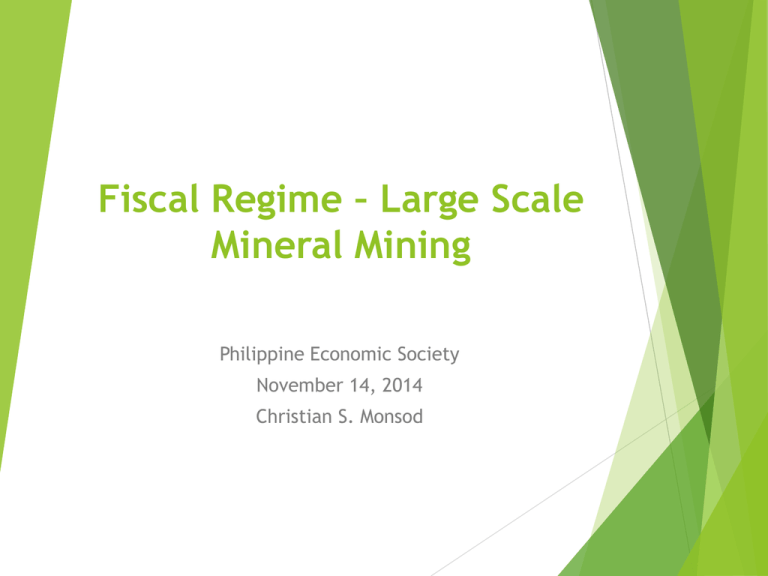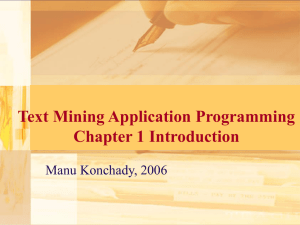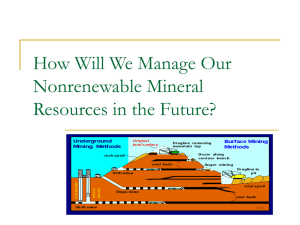Fiscal Regime * Large Scale Mineral Mining
advertisement

Fiscal Regime – Large Scale Mineral Mining Philippine Economic Society November 14, 2014 Christian S. Monsod I’m not here to argue that mining must be banned. Constitution allows it (1) Moreover, value of mineral wealth is huge – about one trillion dollars. While mining has never been a driver of our development, we cannot discount its potential and must find ways to realize it. But present mining framework has clearly not worked. No industrialization based on mineral wealth and an inequitable imbalance in the distribution of its costs and benefits. Mining is a social justice issue…(2) Mining operates in rural and mountainous areas affects farmlands, rivers and shorelines where the poor live and engage in livelihood – farmers, indigenous peoples and subsistence fishermen. Mining is not only about extraction but also exhaustion of non-renewable mineral resources. It is an activity that “privatize benefits and socialize costs.” Mining is a social justice issue (3) Principle encapsulized in Art. XIII, Sec. 1 “…equitably diffusing wealth and political power for the common good.” Also Art. XII, Sec. 1 in goals of the economy: “..more equitable distribution of opportunities, income and wealth” is given more priority over “sustained increase in the amount of goods and services” and “productivity”. But social justice makes good economic sense as well…. (3) NEDA Sec. Arsenio Balisacan says: no longer debatable that sustained high growth is required for poverty reduction and Addressing high inequalities is pre-condition for sustained high economic growth. Worst inequalities are in ownership, or access to, land and natural resources. An equitable fiscal regime in mining should consist of the following: (5) 1) equitable revenue sharing – recognizes that govt has two distinct and separate roles in mining: govt as sovereign taxing power – taxes, fees, charges imposed on ALL individuals and businesses govt as owner of the minerals which is the main input in mining, for which it should be paid its full value. An equitable fiscal regime should consist of the following (6) 2) Equitable sharing of social, environmental and economic costs (“externalities”) 3) Other financial considerations – incentives, royalties, compensation; 4) Capacity of govt to regulate and enforce environmental safeguards 5) Distribution/use of mining revenues None of the 5 are present or are inadequate in the mining regime (7) On revenue sharing: Govt share is capped Mining contractor’s share is open-ended which invariably results in its appropriation of economic rent* – (*excess or windfall profit over and above all costs of production and a reasonable return to investor.) What it should be…. (8) Mining contractor is never a co-owner. Its share should be the one capped to a reasonable return. A mining concession is also a monopoly not only on minerals but also water and forestry; Govt share should be open-ended because excess profit arises from an increase in the price of minerals which it owns, since mining extraction technology is relatively rigid. MICC reforms: revenue sharing major change in current regime (9) a) b) c) Govt affirmed as owner of minerals entitled to the economic rent Gets 10% of gross revenues or 55% of ANMR plus 60% of excess over 50% ANMR margin In lieu of all national and local taxes, CIT, royalty to ICCs, duties on imports and LGU charges and fees MICC reforms: scope of new revenue sharing……… (10) New revenue sharing now applies to both MPSA and FTAA Basis for major correction: owner of minerals is not Filipino majority owner of company but the Filipino people. Present regimes: MPSA – no compensation as owner. FTAA – 5% royalty but AGS watered down. SMI regime, even worse. MICC reforms: on scope of new regime ………. (11) But new regime applies only to future projects. Existing MPSAs and FTAAs deemed protected by “sanctity of contract”. Disputable. SC contract for natural resources is privilege subj. to policy changes. Mining industry zone – carved out of LGUs. Disputable – under General Welfare power of LGUs. MICC reforms: expanded scope of environmental funds*.. (12) No longer limited to damages from normal operations but now includes damages from disasters; Perpetual coverage of maintenance and of disaster damages from permanent structures in both mining areas and impact areas. *(MRF, MTF, RCF, MWTF, ETF, FMR/DF) MICC reforms: no more BOI incentives (13) Repeals Sec. 90 that says that mining activities shall always be included in the investment priorities plan. Mining ”not a footloose industry”. (major change) Other provisions repealed - secs. 80 (MPSA sharing), 81 (govt share), 83 (income tax), 84 (excise tax), 86 (occupation tax), 87 (manner of payment of fees), 88 (allocation of occupation fees), 92 (income tax carry-over) and 93 (accelerated depreciation) of R.A. 7942 Not among the reforms: (14) The front-loading of incentives. Country is shortchanged. Ex. TVI, Rapu-Rapu, SMI; EIS: does not consider biodiversity, ethnodiversity, cumulative effects such as on water and crops; Flawed procedures -EIS not under oath; public hearings discretionary, documents in English, 120 days vs 18 mos to 8 yrs in U.S., presumed approved if no action taken Not among the reforms: govt enforcement capacity … (15) PDP 2011-2016 admits (page 320): - ”..there is no standard resource and environmental valuation” - “capacity for resource mgt is wanting” - “enforcement of environmental law and policies is inadequate..Relevant environment laws, esp. those regulating the utilization of natural resources, are poorly implemented.” Mining approvals should be suspended until these are corrected. Or history will repeat itself. Then, there is putting to use the analytical tools, such as….. (16) WAVES - wealth accounting and ecological systems services to take account of environmental, social and economic factors recently launched by the NEDA In other words, there is still unfinished business ahead if we are serious about reforms. Mining industry’s objections to MICC reforms … (17) It results in an uncompetitive AETR and will deter investments that result in “inclusive growth”, i.e. jobs, more infrastructure, better health and education in hinterlands, forward and backward linkages, etc. Firstly, what deters investments? (18) According to World Investment Report and others – the factors that attract or deter investments are: Adequate infrastructure Skill levels (human capital) Quality of the general regulatory framework Clear Rules of the Game Fiscal determination Graft and corruption With regard to mining investment, the other considerations are……. (19) World demand and supply situation for minerals and products; Comparative quality of minerals and extraction cost Rate of return (IRR) on investments (& AETR) Ref: World Bank (2006) “Mining Royalties. A Global Study of Their Impact on Investors, Government, and Civil Society” by James Otto and others. Secondly, has mining really delivered all those benefits? (20) Historically, all economic indicators of mining are low (labor-output ratio, backward and forward linkages, contribution to GDP, job generation, contribution to govt revenues etc). It is the second highest sector on poverty incidence. Socio-economic projects….(21) The national impact of its sociocommunity projects is negligible because they cover only 711 out of more than 42,000 barangays (data from DENR-MGB) What has mining delivered? (22) The country is shortchanged by the mining fiscal regime (ADB Study 2010 by Habito ) “Undermining the inclusiveness of future growth is the nature of fiscal regime “the largest share of value of output accrues to operating surplus, amounting to 43%, indicating that the benefits from mining accrue primarily to investors…” What about AETR? According to study by African Development Bank (2013) on gold, the Fraser Report (bible of mining industry) says that the percentage of mining companies that would NOT invest because of the fiscal regime do not appear large: Country/Region Percentage USA 3.8% Latin America Eurasia : (23) - 10.6% 5.3% Canada 0.8% Australia - 2.6% Africa 3.4% What about AETR? (24) Comparing AETRs is a useful economic tool but should not be central to our decision-making. Neither is it central to the decision to invest of mining companies. But it’s probably a useful tactic to pit countries against one another. And divert attention from issue of economic rent What really matters?…. (31) If a mining Contractor is getting a reasonable rate of return on its investment, why should AETR matter at all? What does the Contractor consider as a reasonable return? That’s what mining companies asks for in every mining application. The IRR (plus WIR factors) more relevant to decision-making … (32) The World Bank study (2006). The top 12 (of 24 countries), IRR range = 12.6% to maximum of 15.7%; Philippines (rank 5) IRR of 13.5% AETR of 45.3 Zimbabwe (rank 5) IRR of 13.5%, AETR of 39.8% South Africa (rank 5) IRR of 13.5%, AETR of 45% PNG (ranked 4) IRR of 13.8%, AETR of 42.7% Chamber of Mines (33) COM submission of IRR range of selected countries: 12.7%-18.2% (average 15.9%). Phil-MICC has lowest IRR (with AETR 81.4%); PNG has highest IRR (with AETR of 32.7%). Copper at $3.05/lb, gold at 1,200/oz. Some projections ….. (34) Projections based on data in SMI project study : - current tax, copper $3/lb, gold $1300/oz, IRR= 21% - current tax, copper $3.50/lb, gold 1400/oz, IRR = 27% - at 50% ANMR, copper $3.50, gold 1400/oz, IRR = 19% If capital is leveraged w/ debt equity ratio at 60-40, return on equity would be higher. How much in real money are we talking about? (35) Estimate of shift in government share of gross revenues by reason of the MICC proposal is estimated at about 2% from the present FTAA fiscal regime. SMI gross sales over 18-yr period, base case is about $43 billion. The $860 million (43 x 2%) difference represents the additional revenue to govt and the reduction of the Contractor profit from $16b to $15.14b. Status of MICC proposal (36) Not yet filed with Congress. President still waiting for more analysis from MICC-TWG. Question to Mining Industry: If the TWG MICCIRR for mining contractor is about 15%, is that a reasonable rate to the mining industry? Or is the issue, not the level of the IRR, but the economic rent in the 21%-27% ? Conclusion (37) Volatility of data suggests caution in interpreting figures, tax regimes are moving targets. And our legislators are easily taken by expert academic studies. According to WIR, African Development Bank, ADB, IDEA and others, most countries are re-negotiating (and increasing) government total “take” and taking account of economic rent. Are we serious about reform? (38) History shows mining has had its way with us for over 50 years with unacceptable results. If we are serious about reform, we should pursue our own vision, as others are already doing. Thank you. Extra slides No need for these Two FTAA holders unwittingly disclose excessive profits in pending SC case Sagittarius Mining “….respondent SMI’s projection based on gold price of US $1,500/oz and Copper at $3.5/lb is that the 2-year average ratio (.n.b. net profit to gross revenue) would be beween 0.40 to 0.69 – with a recovery period of 2.5 years.” Since “AGS” (additional govt share) does not arise until mining contractor fully recovers all its investments and pre-operating expenses, this implies that the rate of return during the 2 ½ years would be 40%/year. OceanaGold Mining: same situation “ OceanaGold undertook financial modeling…. the conclusion…there would in fact be an additional 14.4 Billion going to the government….it will happen in October 2016, even before the 5-year recovery period.” This implies a 33%-40% return on investment during the recovery period. Context of reforms… Ample Foreign Exchange Reserves, thanks to OFWs New analytical tools to measure environmental, social and economic costs (WAVES. TEV, multi-hazard and climate change mapping. etc). Promulgation of the Precautionary Principle by the SC and already agreed to by the Philippines in the Rio Convention. Lower interest rate and cost of capital worldwide Instead, the mining industry shifts to the bogus argument of static comparison of Average Effective Tax Rate (AETR) of other countries. When almost all mineral countries are reviewing fiscal regimes to increase their take due inequitable agreements. World Investment Report of 2012 -- need for new generation of investment agreements to promote inclusive growth and correct unfavorable contracts to developing countries Proposed corrective measures.. (1) (1) Govt as owner gets economic rent. Cap is applied to mining contractor. Rate of return of Contractor can admit of penalties and bonuses. (2) Remove all fiscal incentives (mining not footloose industry) (3) With higher take, remove royalties paid to IPs and social community projects which govt should provide anyway. People will no longer feel indebted to mining companies but to their government, and can express real feelings about it. (CIT also removable with right GR tax/Ec.rent approach) (4) Rationalize distribution and timely delivery of LGUs’ share Proposed corrective measures ….(2) (4) Earmark revenues from mining to create replacement capital for lost minerals, i.e. with manufactured capital (infrastructure) and social capital (human resources). (5) There are only 6 FTAA; only one in operation, another on slow implementation. MPSAs on notice with La Bugal decision where both majority and minority agreed that government should get more than taxes. Manageable, in case of renegotiation or litigation; (6) Revisit flawed La Bugal SC decision (Supreme Court) Proposed corrective measures……(4) (7) No mining approvals until institutional capacity of govt to handle evaluation and enforce laws is in place. Otherwise, 50-year history of being shortchanged will continue. EO 79 is not unconstitutional (8) New rules on no-go areas and environmental protection should apply to existing mining operations. Jurisprudence supports exercise of police power and no violation of “contract clause”. The context of mining in the international investment environment. There is a need for a “new generation of policies” in the light of findings that investment agreements, particularly on extractive industries, found wanting in two major aspects – (1) they do not take account of the requirements of sustainable development and inclusive growth, and (2) there has heretofore been an imbalance in the benefits and costs assumed by the government and by the investors, with the governments at a disadvantage. (UNCTAD’s World Investment Report of 2012) Environmental protection funds MRF - (a) MTF at least P150,000 (b) RCF (Rehab Cash Fund) – Revolving w max of P5m. MWTF (Mine waste and tailings fund) – P0.10/mt & P0.05/mt mine wastes. ETF excludes disasters FMR/DF –up to 10 yrs maintenance. Capital cost only for decommissioning and final rehab. None for disasters on permanent structures. Institutional funds to safeguard the environment no longer limited to damages from normal operations but now includes damages from disasters (corrects gap) Requirement of perpetual coverage of maintenance and disaster costs of permanent structure for damages in both mining areas and impact areas (corrects gap) More on ADB study…. (25) “In terms of employment generation, mining and quarrying has relatively low laboroutput ratios. Labor accounts for only 13.35% of the sector’s output against an economy-wide average of 20.7%. More on the ADB study.. (27) “… mining has contributed a relatively miniscule share of national GDP over the years…. an average of only 1.444% of the country’s total GDP since 1975. “Job generation in the mining sector is low. …. “…14 workers were employed for every P1 million of mining Gross Value Added (GVA ) in 1980, by 2004 this was down to 6 workers per P1 million of GVA. More on ADB study…… (28) …… The other and more prominent concern in mining is the environmental and social impact of mining activities, especially in uplands and indigenous lands.” Question… (29) Is there a real cost to foregoing mining investment if it is not on our own terms? More on ADB study…. (26) “With a backward linkage index of only .460, the industry uses relatively little input from other domestic industries. “..low forward linkage index of .82 forward linkages are below the average for all sectors of the economy. ..industry’s products are exported in primary form, with little processing taking place within the country.” Does mining really produce all those benefits? (23) After 50 years of mining - no industrialization footprint based on mining. Biggest mining investment ($5.9 billion SMI) exports ore. No downstreaming plants to increase value added. Employment is 10,000 construction plus 2,000 permanent = P10,000,000/job. On Extractive Industry Transparency Initiative… (30) EITI is a promising development. Past mining industry made similar promises. Present disowns corrupt/abusive practices of the past. On disasters: “… even the screw-ups have to be placed in the proper perspective. We are but human, and mistakes and accidents do occur every now and then, in any industry.”







